For most parents, planning for a new baby (whether it’s the first or the fifth!) means a heightened awareness of the different items, materials, and chemicals in the environment around their home.
Considering that babies sleep so much, creating a healthy sleep environment that’s free from as many toxic chemicals as possible is an essential for most parents. Of course, that means getting a non-toxic crib, and organic crib mattress, and an organic mattress protector and/or fitted sheet.
Although everyone will have slightly different needs and preferences, we’ve done most of the initial research for you and narrowed down the best non-toxic and natural wood cribs for you in this guide. We hope it saves you some valuable time and energy as you prepare for your new little one!
By the way, here are a few related articles you might be interested in as well:
- Here are the best organic and non-toxic crib mattresses
- Here’s where to find non-toxic bassinets
- These are the best non-toxic high chairs
Table of Contents
This article contains affiliate links, which means we may earn a commission if you decide to make a purchase. We only make recommendations that are genuine and meet our standards!
Featured Image Credit: Babyletto
What to Look for in a Non-Toxic Crib
There are really only two “parts” of a crib when it comes to be concerned with when it comes to materials: what the actual crib is made out of (usually wood) and what it’s finished with (usually either some sort of oil or paint).
1. Solid Wood vs. Engineered Wood
Ideally, you’ll want to choose a crib that’s made out of natural solid wood as opposed to engineered wood. Engineered wood includes things like plywood, medium-density fiberboard (MDF), and particleboard.
The main concern with engineered wood is the amount of formaldehyde it contains. Engineered or manufactured wood is actually made by gluing together a lot of different wood pieces, including things like sawdust and wood chips, in order to make something that resembles real solid wood. But the problem is that a LOT of glue is required to do make engineered wood, and that glue can contain pretty high amounts of formaldehyde.
Formaldehyde is a skin and respiratory irritant and carcinogen. Although it’s a naturally-occurring substance (it’s even in human bodies in small amounts), it’s now in our environments in too-high amounts because of things like MDF furniture, hair products, and more.
This is why you’ll want to choose solid wood cribs whenever possible. You’ll notice that the brands below use almost all solid wood. However some of the brands use MDF for portions of some of their cribs, so you’ll just want to double check before purchasing. (We’ve noted which ones use MDF in some of their products.) It can be difficult to find brands that use 100% solid wood in ALL of their products, but there are a few (such as Green Cradle) that do!
If you’re using hand-me-down furniture for your nursery or end up choosing a crib that uses plywood because of budget or other reasons, then you can consider putting some AFM Safecoat Safe Seal over it in order to reduce the amount of off-gassing.
Are Metal Cribs Safe?
When considering whether or not to use a metal crib, you’ll want to consider a few things:
- First, you’ll want to make sure the metal crib you’re using is tested to be free from heavy metals like lead and cadmium.
2. Second, you’ll want to stay away from cribs that are older than ~10 years old. Antique cribs may not have updated safety features and they’re also more likely to contains toxins like lead.
3. Lastly, there is the issue of EMF conduction. Some believe that metal cribs, bed frames, and other pieces of furniture conduct electromagnetic radiation (from things like wifi routers and cell phone towers) more than other materials like wood. Although we need more research on EMFs, if you’d like to take a “precautionary approach” then you will probably want to stick with natural wood instead of metal for your baby’s crib.
2. Finished vs. Unfinished vs. Painted
The next question is what the wood is finished with.
Unfinished wood is a great option because, honestly, leaving the finish off means one less source of potentially toxic chemicals you have to worry about! But of course, unfinished wood tends to get nicked and scratched more easily, which is an important consideration when it comes to making your kids’ furniture last as long as possible.
If you don’t want to go with an unfinished wooden crib, another great option is to get a crib that’s finished with a natural oil (usually linseed) or a water-based, low-VOC finish or paint. Paints and finishes can contain all kinds of different volatile organic compounds (a.k.a. VOCs) such as formaldehyde, carcinogenic BTEX chemicals (benzene, toluene, ethylbenzene, xylene), and more. Over time, these chemicals can “off-gas” into the air, decreasing indoor air quality. (And of course, your child can ingest them if and when they put their mouth on the crib as well!)
Although parents should still watch out for paint that contains lead, this isn’t as much of a problem as it was several decades ago.
In order to give yourself a greater level of transparency and control over what exactly your little one’s bed is made out of, you could consider buying an unfinished crib and then finishing or painting it using a product of your choice, such as AFM Safecoat paint or natural linseed oil.
Should a Crib Be GREENGUARD Certified?
Although third-party certifications such as GREENGUARD are not perfect, they’re usually a good thing to look for. A GREENGUARD Gold certification limits the amount of VOCs that a crib is allowed to emit, so it essentially means that it will have a minimal impact on your indoor air quality compared to more conventional (uncertified) cribs.
Although we do look for GREENGUARD Gold certifications, it’s worth noting that not all GREENGUARD Gold certified products are perfect. (For example, it’s possible to use engineered wood while still earning a GREENGUARD label.) Similarly, just because a brand does not have a GREENGUARD certification doesn’t mean it’s automatically. Some brands may choose not to obtain a certification for various reasons, one of the main ones being the extra cost required to obtain and maintain the certification. Green Cradle, for example, is one of the best brands for non-toxic cribs in terms of material safety, and yet their products do not carry the GREENGUARD label.
In other words: a GREENGUARD Gold certification is a great thing to look for when shopping for low-tox products, but it is not the end-all-be-all.
Most (although not all) of the brands below carry GREENGUARD Gold certified cribs.
Other Things to Consider in a Crib
In addition to looking for safe and natural materials, there are some other things to consider when choosing which crib is the best for your family:
1. Size & Shape
Most cribs come in the same “standard size” of 51-52″ by 27-28″. The main reason crib size is important is because parents need to make sure that the crib mattress fits snuggly into the crib, with no gaps larger than two fingers between the sides of the crib and the mattress. This is important in preventing your baby from getting trapped in those gaps.
Depending on your space, travel plans, budget, and aesthetic preferences, you may choose to get a different shape or size for your crib, like a mini crib or an oval crib. But again, the most important thing is that your mattress fits with your crib properly.
2. Adjustable Mattress Height
Many cribs have adjustable bases that allow you to move the mattress down as your baby grows. This makes it easier to lift your baby in and out of the crib, but then prevents your baby from being able to climb over the railing as they grow and start moving around more.
3. Other Safety Standards
In addition to non-toxic materials, you’ll also want to make sure you’re getting a crib that meets ATSM International and Consumer Product Safety Commission (CPSC) safety standards, which prevent things like breaking, pinching, falling, etc. Most of our recommended brands meet or exceed the safety standards for numerous countries, including the the U.S., E.U., Canada, and Australia.
As long as you’re purchasing a crib from a legit brand or retailer, you shouldn’t have an issue here.
Use other safe sleep practices as well, such as:
- keeping blankets, pillows, and stuffed animals out of the crib
- keeping the crib away from things like curtains and baby monitor cords
- keeping an eye on recalls
Check out the CPSC and/or talk to your pediatrician for more resources on keeping your baby safe while they sleep.
4. Convertibility
Considering how fast babies grow, you might want to consider getting a crib that converts into a toddler bed, kid bed, or even an adult bed. This can safe you money, waste, and hassle in the long run.
Many of the non-toxic crib brands below can be converted in several different ways. Sometimes you have to buy a conversion kit separately, so just make sure you check before buying.
5. Price
You’ll probably be thinking about budget as well. Most of the brands below are between the $500 and $1,000 range. That price might go up if you add in the potential to convert the crib into a bed, but that could end up saving you money over time. At the end of the day, you’re the only one who can make the best decision for you!
How To Choose a Crib Mattress
As mentioned above, you want to make sure your crib mattress fits snuggly in the crib in order to prevent your baby from getting trapped in any gaps.
While some brands, such as Savvy Rest and Green Cradle, offer BOTH non-toxic cribs and organic mattresses, you may actually want to buy the two items separately. For example, Naturepedic is one of our favorite brands for organic crib mattresses, but they don’t actually sell cribs.
For our full guide to non-toxic and organic crib mattresses, check out this guide.
Home
8 Best Organic & Non-Toxic Crib Mattresses
Babies spend a LOT of time sleeping, and their developing bodies (and minds!) are more vulnerable to environmental toxins. That’s why choosing an organic crib mattress is important. Here’s what to look for and our favorite non-toxic crib mattress brands.
Our Recommendations for the Best Non-Toxic Cribs
Okay, now let’s get on to our recommended brands for non-toxic and natural solid wood cribs to encourage a safe and healthy sleep environment for your little one.
Green Cradle

Price: $1,545-$3,295
Convertible? Yes, with the proper conversion kids, this crib can be converted 7 different ways, including to a full-sized bed.
Green Cradle is one of the best brands for a non-toxic and eco-friendly crib for a few reasons. First, even though these cribs are on the pricier side they can be converted into SEVEN different pieces of furniture! So even if you end up spending a few grand on one of these cribs, it will likely last you decades.
The second reason Green Cradle is great is because they have some of the most safe and transparent information in terms of materials used. Completely free from potentially harmful toxins, they use all solid wood, with absolutely no MDF, plywood, or other types of engineered wood anywhere. They only use natural linseed oil for the finish, which is one of the very safest non-toxic finish options available. They’re also tested for lead, cadmium, and phthalates and are Prop 65 compliant.
They offer about 12 crib designs which offer different kinds of aesthetics. Each hardwood crib is available in different types/colors, including Maple, Oak, Cherry, and Walnut. (Or you can choose unfinished if you want.) All of Green Cradle’s cribs are made in the USA.
In addition to their cribs, Green Cradle also offers smaller bassinets and a moses basket, dressers and changing tables, organic crib mattresses, and other organic baby bedding like mattress pads and fitted sheets.
Savvy Rest
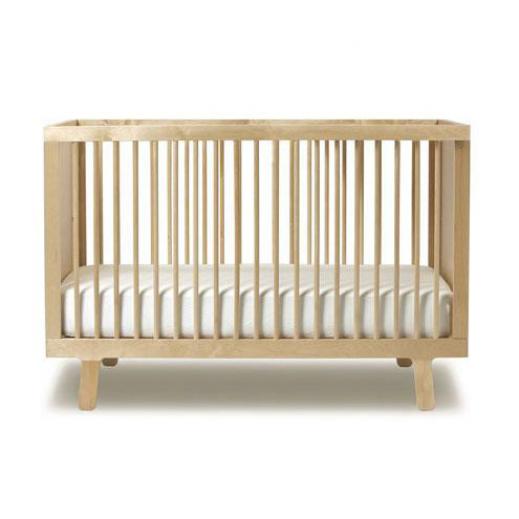

Price: $960 (before discount)
Convertible? Yes, with toddler bed conversion kit which is sold separately (can last up to age 5)
In addition to their two different crib mattresses, Savvy Rest makes hardwood cribs that come in three different colors: natural (unfinished) birch, white, or walnut. Although the majority of the crib is made from solid birch, the bottom rail and legs are made with Baltic birch plywood. It’s finished with non-toxic and water-based finishes and is GREENGUARD Gold certified.
This crib is pretty simple to assemble and comes with three adjustable mattress heights. You can also purchase a conversion kit in order to turn your crib into a toddler bed, which will last your child up until about age 5.
Savvy Rest is a certified B Corp brand and an employee-owned company, too!
Use the code THEFILTERY20 for 20% off.
Babyletto

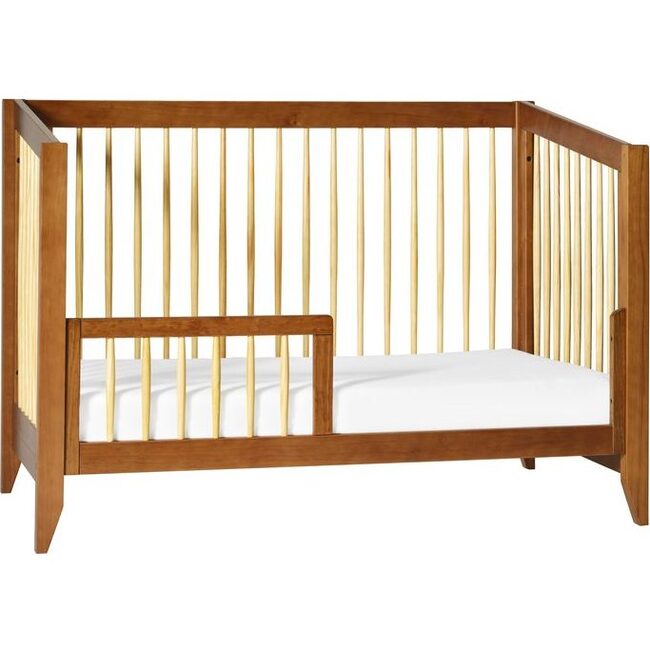
Price: $299-$649
Convertible? Yes, 3-in-1 convertible cribs last until age four, and 4-in-1 beds can be turned into full-sized bed frames with an extra conversion kit.
Out of all of our recommended brands, Babyletto probably has the most options to choose from. They offer mini cribs and bassinets, conversion toddler beds, and cribs with storage options as well. They’re available in unfinished or painted/stained in various colors.
Babyletto’s cribs are made out of solid New Zealand pine wood along with lead- and phthalate-free paints & stains. They are all GREENGUARD Gold Certified. (Note that the cribs that have drawers use some plywood.)
Most of their cribs are 3-in-1, which means they can go from a baby crib to a toddler bed (with a side rail) and then to a day bed, lasting up until about 4 years old. They also have some 4-in-1 options, which you can turn into full-sized bed frames with an extra conversion kit—meaning your crib can essentially last your child’s entire lifetime!
Although Babyletto offers crib mattresses too, we don’t recommend them as highly. Both their “Pure Core” and their “Coco Core” varieties employ synthetics like polyester. Even though the “Coco Core” mattresses include more natural materials, none of them are organic. They also run anywhere from $129 to $289, but if you’re going to spend that much on a crib mattress, we recommend going with a more fully organic option, like the brands listed here.
Kalon

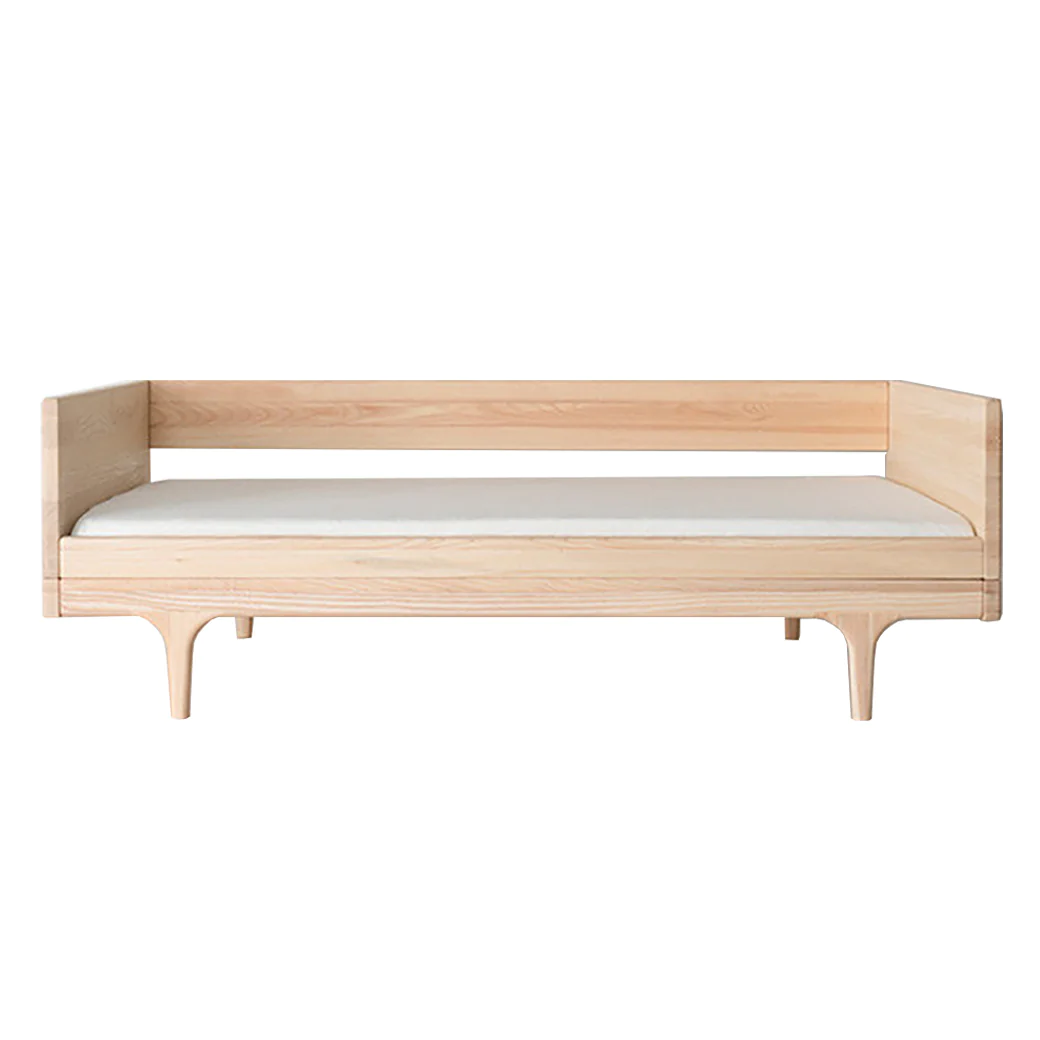
Price: $1,495
Convertible? Yes, a conversion kit can be purchased separately
Kalon offers a natural wooden crib with a smooth and minimalistic aesthetic. It’s made from solid European Ash hardwood and then lightly finished with a non-toxic and food-safe oil. (Note that the mattress support is made from plywood.)
With the purchase of a conversion kit, you can turn this crib into a toddler bed, backless divan, or low sofa/daybed. They also offer a compatible organic crib mattress to go with your crib as well as a few different sizes of dressers and a changing tables.
Bloom
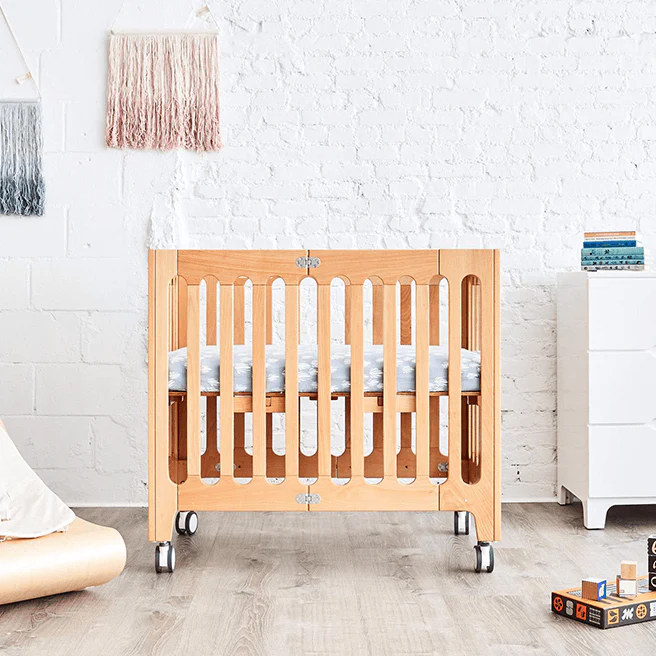

Price: $529-$899
Convertible? Yes, depending on which crib you choose, it can last you up to give year (with conversion kits sold separately)
Bloom offers several different kinds of cribs, including “mini” and “max” sizes. The main thing that sets Bloom cribs apart is that they fold flat and have lockable wheels, making them good for small spaces, travel, and storage. (This is a great option for grandparents’ house!)
They’re made in the USA out of solid, MDF-free wood and low-VOC finishes. Assembly is easy, too—you don’t even need tools!
Bloom also offers organic bedding and a mattress. Although the mattress is GREENGUARD Gold and OEKO-TEX certified, it’s not completely organic (or even clear what it’s entirely made out of), so we can’t give the mattress our full recommendation.
dadada
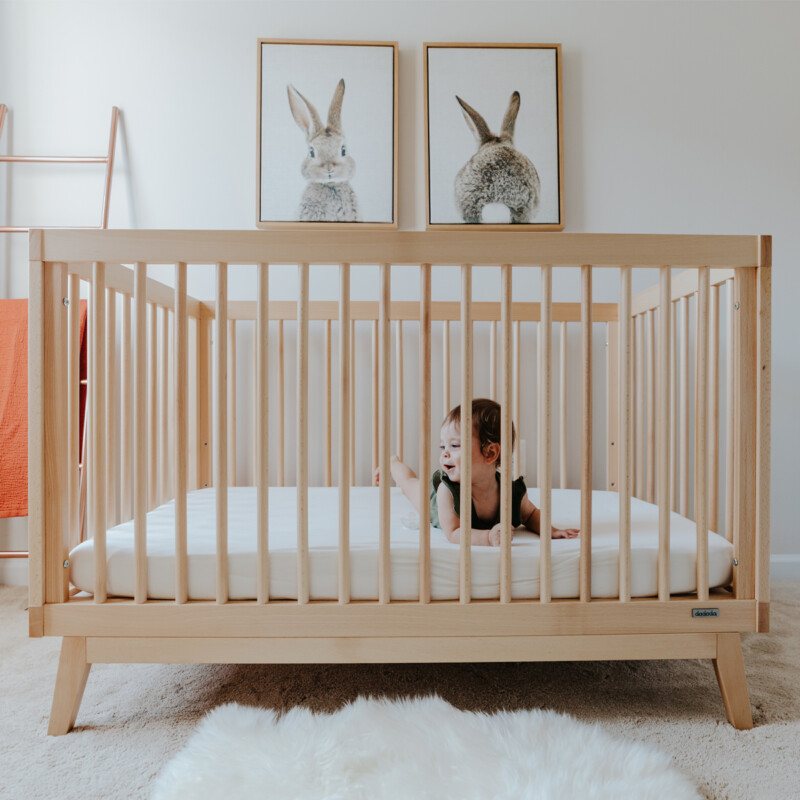

Price: $499-$599
Convertible? Yes, most cribs are 3-in-1, so you can add a toddler rail (sold separately) and then take that off to make a day bed.
dadada offers several different crib designs, which are available in natural and white as well as several different colors. All of their cribs are made in Italy and come with a GREENGUARD Gold certification. They’re made with solid beech wood and non-toxic finishes that are free from things like lead and phthalates.
In addition to having three adjustable mattress heights, most of their cribs can be converted into toddler beds (with a separate railing) and then a day bed as your child grows.
dadada also offers dressers for the nursery, but these do utilize MDF wood.
ducduc

Price: $995
Convertible? Yes, with purchase of toddler rail which is sold separately
ducduc offers a few different non-toxic cribs that are available in white/natural, “fern green,” and “midnight” blue. They’re all made in the USA out of solid hardwoods and water-based, low-VOC finishes.
The cribs offer four adjustable mattress positions that you can adjust as your baby grows. Then when they become a toddler, you can take the front side of the crib off and swap it with a toddler rail. Plus, ducduc’s cribs and other products are specifically designed to be super easy to assemble—it can be done in as little as 15 minutes!
ducduc also carries lots of other furniture for nurseries and kids’ rooms, too—like dressers, bed frames, changing tables, bookshelves, and more.
Stokke
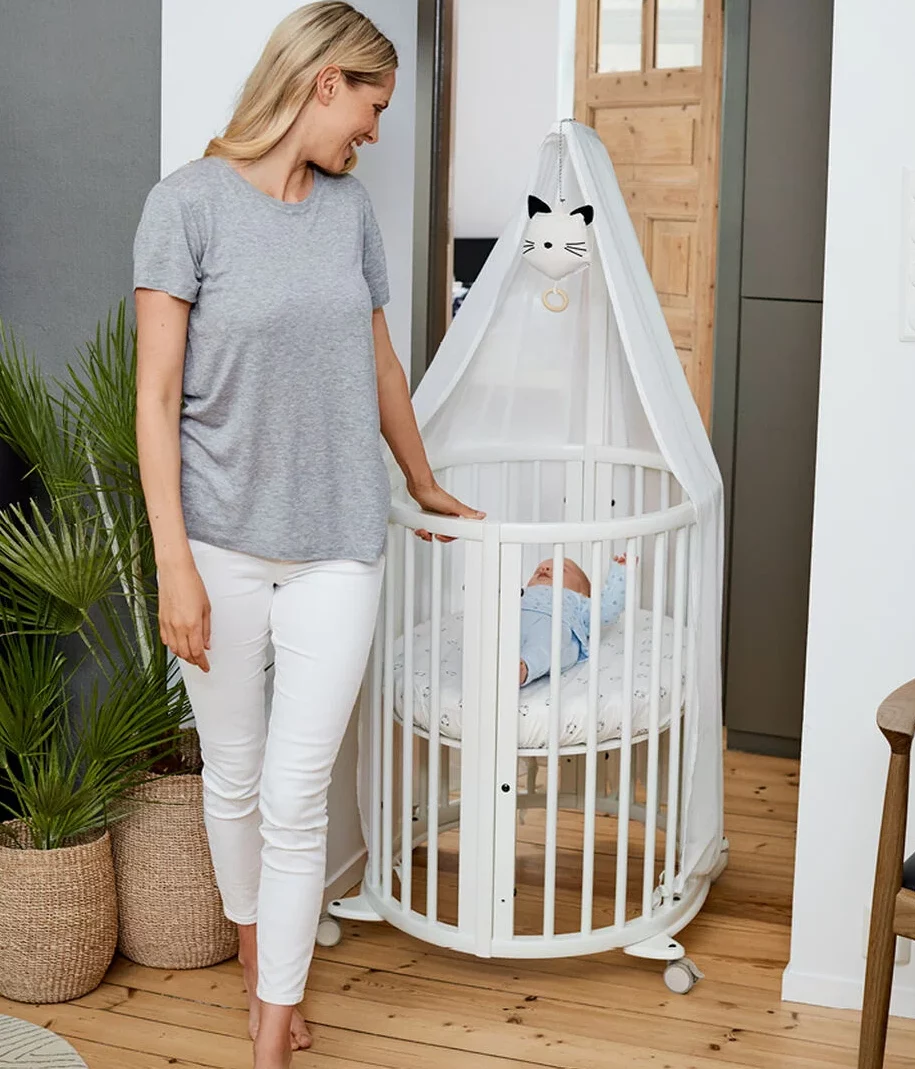
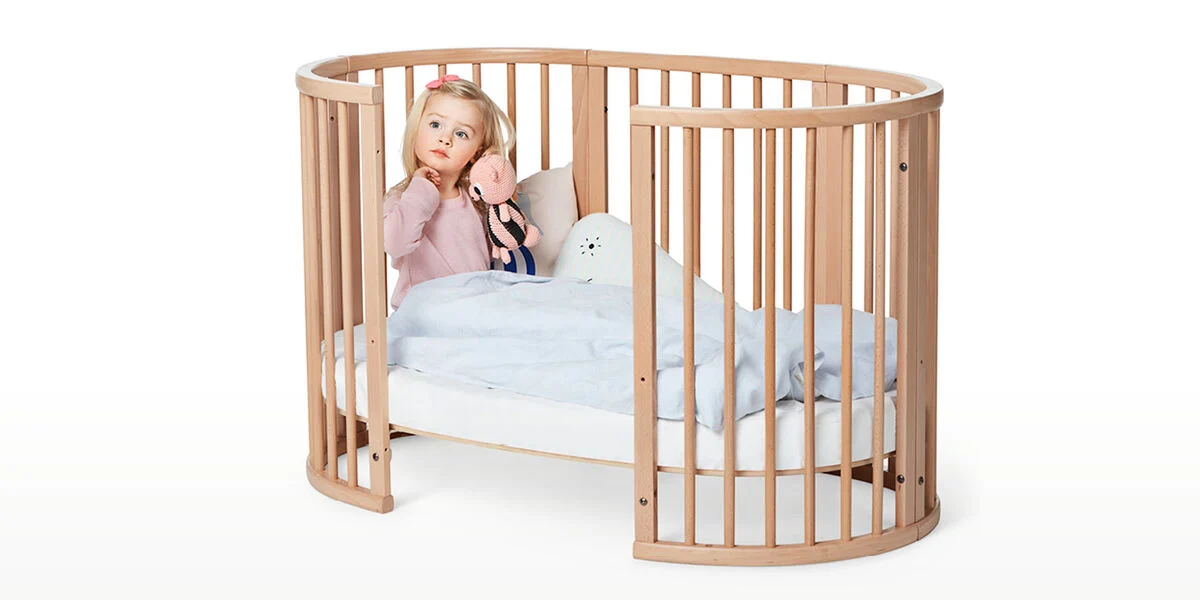
Price: $499-$749
Convertible? Yes, the Stokke Sleepi is a 4-in-1 bed that can last up to age 10.
Stokke makes some of the most popular non-toxic high chairs, but they also carry natural wood crib as well.
Available in white, natural, or gray, the Stokke Sleepi is an oval crib that can be converted from a newborn “mini” crib, to a larger crib for an older baby, to a toddler bed, and lastly to a kid bed. It also has an adjustable mattress height and lockable wheels that make it easier to move the crib from room to room if you want to.
Nestig

Price: $499-$699
Convertible? Yes, their 3-in-1 cribs can be used until your child is 50 pounds, and you don’t need to purchase any separate conversion kits.
Nestig is a new eco-friendly crib company that’s growing in popularity. They offer several different 3-in-1 conversion cribs which are available in “natural,” white, green, and a few other colors. Like our recommended brands, Nestig cribs offer adjustable mattress heights and locking wheels, and they can be converted into a toddler bed as your child grows.
They’re handmade in Brazil in a family-owned factory and are made-to-order to decrease waste. The majority of the crib is made out of solid Brazilian pine wood BUT they do use “eco-engineered wood” for the mattress support portion of the crib. Although this isn’t ideal, it still means the crib has a lot less formaldehyde compared to a crib that’s made entirely out of conventional MDF.
Other selling points include free shipping, a 60-day free trial, and an 18 year limited warranty. Plus, the conversion kits come with your original purchase so you don’t have to buy anything separately to convert your crib to a toddler bed. Lastly, Nestig carries Naturepedic’s organic crib mattresses (which we love!) and organic cotton sheets, so you can get everything you need for your baby’s slumber in one place.
Are IKEA Cribs Non-Toxic?
IKEA’s furniture definitely has pros and cons. When it comes to chemical safety policies, they’re actually pretty good compared to other large retailers. (For example, they banned PFAS back in 2016 and they don’t use any flame retardants unless required by law in the region the furniture is being sold.)
However, they do use a lot of synthetic material, engineered wood, and acrylic lacquers throughout their product lines (including cribs).
Of course, IKEA is often more affordable than other brands, which is certainly a selling point! If you do want to go with an IKEA crib, we recommend getting the SNIGLAR crib because it’s made out of solid beech wood and is unfinished. All of the other IKEA cribs we looked at utilize engineered wood as well as harsh acrylic paints and lacquers.
You can read more in our full IKEA breakdown right here.
Home
Is IKEA Furniture Non-Toxic?
Is IKEA’s furniture non-toxic? Does it contain toxic chemicals like flame retardants, PFAS, formaldehyde, or phthalates? We’re giving you all the answers!
If you or someone you know is trying to reduce their child’s exposure to toxic chemicals, go for a solid wood crib that is either unfinished or finished with a natural oil or low-VOC / non-toxic paint. Try to avoid engineered or composite wood when possible when shopping for children’s furniture. To finish out your baby’s nursery, look for crib mattresses and sheets that are made out of organic materials like cotton, wool, and natural latex.


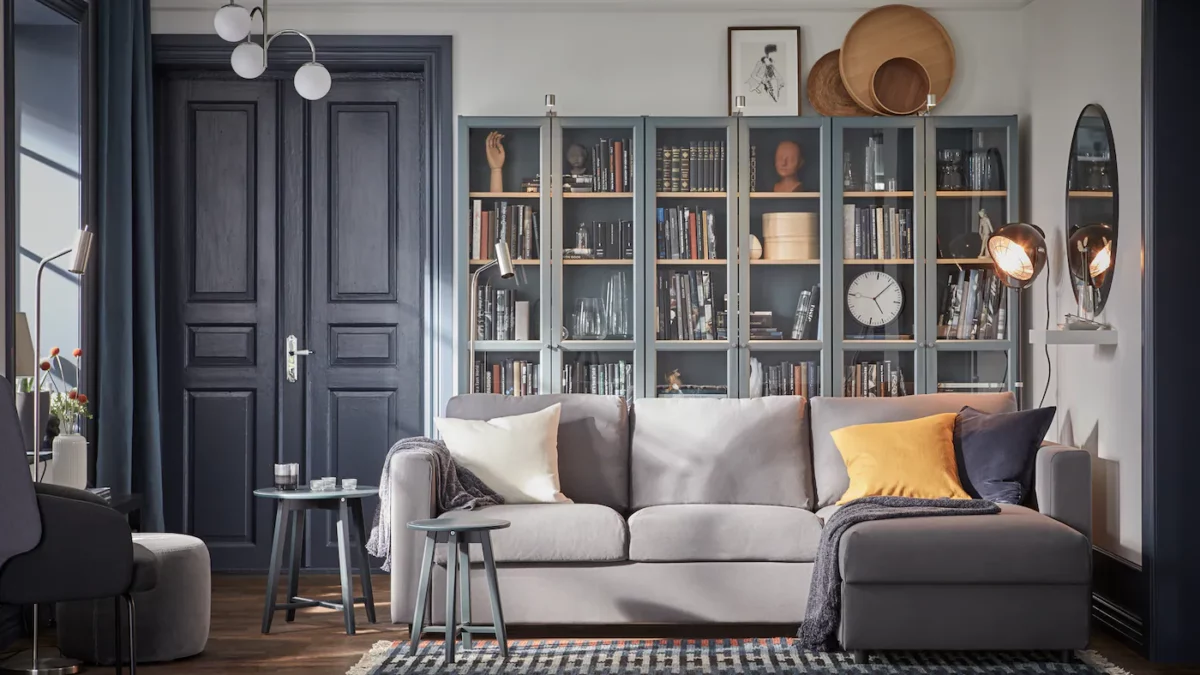




I’ve been looking for a safe non-toxic crib, I’m interesting in getting the dadada but I noticed that even though the website say their cribs Soho, Chicago, and Austin cribs are GREENGUARD GOLD certified, when I look in the The GREENGUARD Certification Database they don’t show up. I reached out to Dadada company a week ago but they haven’t replied to my email.
I wonder if there’s another way to be sure these cribs are certified or we just need to trust the company.
https://spot.ul.com/main-app/products/catalog/?keywords=dadada
Hey Andrea,
Hmm… The dadada cribs are actually showing up for me in the Greenguard Gold database (in the link you sent and when I tried on my own as well). I wonder if it was actually a technical issue with the database itself? Maybe try a different browser or try clearing your cache and then try again and see if it shows up.